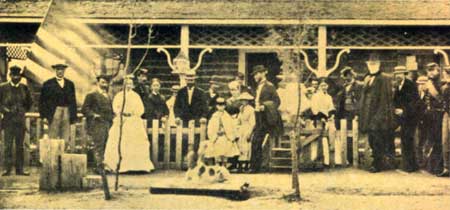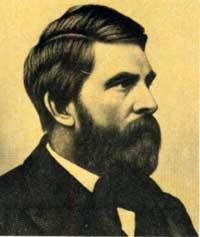|
GOLDEN SPIKE National Historic Site |
 |

Gen. U.S. Grant and party at Fort Sanders, 1868.
Union Pacific
Progress of the Union Pacific
From Omaha up the Platte Valley to the Wyoming Black Hills, the Union Pacific had easy going. The level valley of the Platte River presented few engineering problems. While the Central Pacific struggled in the Sierra, the Union Pacific's grade and track advanced steadily and smoothly.
The Union Pacific followed the old Oregon Trail up Nebraska's Platte Valley. It did not, however, cross the Continental Divide at famous South Pass. In 1865, still in uniform and campaigning against hostile Indians, General Dodge had accidentally discovered what he thought might be a practicable pass across the Wyoming Black Hills. Examination of this pass by U.P. surveyors confirmed Dodge's suspicions. Through Wyoming, therefore, the Union Pacific kept south of the Platte and the Sweetwater, thus considerably shortening the route.
But the Union Pacific faced an obstacle that never troubled the Central Pacific, and in Nebraska it appeared in its ugliest form. The Sioux and Cheyenne Indians possessed a strength and a will to resist that the Paiutes of Nevada had long since lost. As the U.P. invaded their country, the dullest native soon understood what the rails meant to the Indian way of life. War parties swept down on surveyors, graders, and track-layers, then vanished before pursuit could be organized. Appreciating the importance of the railroad to their own task of destroying the Indian barrier, Generals Grant and Sherman stripped the frontier of troops to place large forces on the line of the Union Pacific. Forts sprang up along the right-of-way—McPherson, Sedgewick, Morgan, D. A. Russell, and Sanders. Soldiers guarded the construction workers and rode with the surveyors.
In the Wyoming Basin, where the road penetrated Sioux country, the surveying parties, with their small cavalry escorts, bore the brunt of Indian hostility. One tragedy occurred in June 1867, when Sioux warriors attacked Assistant Engineer Percy T. Browne and eight cavalrymen. Forting up on a knoll, Browne and his men held the Indians at bay until dusk, when Browne caught a bullet in the stomach. The warriors withdrew during the night, and the soldiers carried Browne on a blanket litter 15 miles to LaClede Station of the Overland Stage Company. There he died.
On August 6, 1867, with railhead far out in Wyoming, Indians struck near Plum Creek, Nebr. (present-day Lexington). Chief Turkey Leg's Cheyennes descended on the railroad and, as one of the Indians later recalled, "we got a big stick, and just before sundown one day tied it to the rails and sat down to watch and see what would happen." First came a handcar, which struck the "big stick" and sent its passengers flying. The Indians killed them, except for a man named Thompson, who was scalped but did not die. (A warrior dropped the scalp and Thompson retrieved it. Later, recovering from his wounds, he tried unsuccessfully to grow it back in place. For years it was on display in a jar of alcohol at the Council Bluffs Public Library.) Delighted with their first success, the Cheyennes next pried up some rails. A freight train came along, ran off the track, and piled up, a mass of flames, in a ravine next to the roadbed. Another train, following the first, quickly reversed itself and backed out of the danger area. The Indians broke into the freight cars and had a grand party with the contents—barrels of whiskey, bolts of calico, ribbons, bonnets, boots, and hats. All the following day they indulged in an orgy of fun-making, like children set free in a toy store. Finally, just as the raiders were leaving, a train loaded with Maj. Frank North's battalion of Pawnee Indian scouts steamed up to the wreck and hastened the departure.
 Grenville M. Dodge Library of Congress |
In the Black Hills the Union Pacific encountered its first difficult country and began to draw $48,000 a mile in subsidy bonds. Here, also, smoldering personal animosities within the U.P. hierarchy reached a crisis in the summer of 1868. Consulting Engineer Silas Seymour, Vice President Durant's man at the front, changed and lengthened a location that Dodge had accepted. Durant came west to support Seymour, and probably to try forcing Dodge's resignation. At a tense conference at Fort Sanders, Wyo., a shaky truce was reached. Dodge would be allowed to locate the line of the road without further interference from Seymour. Also present at the conference were Ulysses S. Grant, who was touring the West as part of his presidential campaign, Generals William T. Sherman and Philip H. Sheridan, who were accompanying Grant through this part of the country, and an array of lesser civil and military notables.
The Union Pacific kept its stride. In 1865 it graded and bridged 100 miles and laid 40 miles of track. In 1866 it completed 265 miles of road; in 1867, 245 miles; and in 1868, 350 miles. In the winter of 1868-69 the rails moved into the rugged Wasatch Mountains where, on the summit and in Weber and Echo Canyons, the U.P. experienced on a lesser scale something of the ordeal that the C.P. had endured in the Sierra.
Surveying parties of both railroads pushed into the Great Salt Lake Basin. Brigham Young, powerful president of the Mormon Church, expected the rails to come through Salt Lake City. But a route around the north end of Great Salt Lake possessed decided advantages, besides avoiding the treacherous salt flats west of the city. The Union Pacific chose to turn north at Ogden and follow the north shore of the lake, bypassing the Utah capital. Young was furious, and he threatened to withhold the Mormon aid on which the U.P. had counted. However, when he discovered that the C.P. had also settled upon the northern route, he accepted the decision and threw the support of the church to both the Union Pacific and the Central Pacific, meanwhile organizing his own Utah Central Railroad to connect Salt Lake City with Ogden.

(click on image for an enlargement in a new window)

|
|
Last Modified: Sat, Sep 28 2002 10:00:00 pm PDT |


